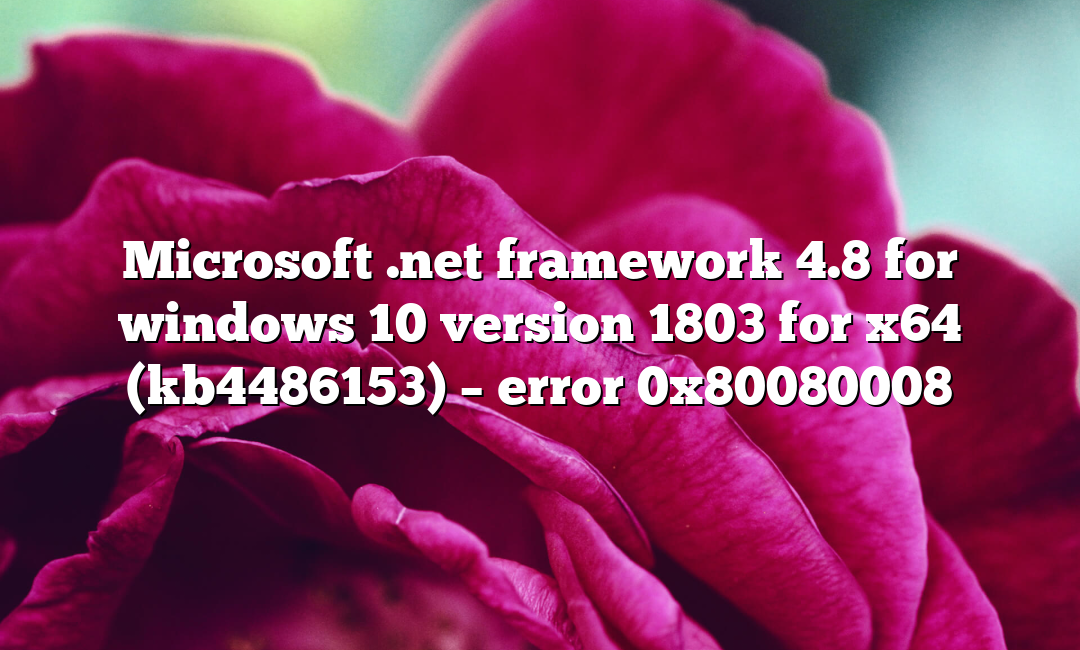Microsoft .net framework 4.8 for windows 10 version 1803 for x64 (kb4486153) – error 0x80080008
In the realm of Windows 10 x64 updates, encountering errors like KB4486153 Error 0x80080008 can be frustrating and perplexing. This error often occurs during the installation or updating process, leaving users puzzled about its origin and solution. In this comprehensive guide, we will delve into the intricacies of this error, understand its underlying causes, and explore effective solutions to resolve it.
Understanding KB4486153 Error 0x80080008
Before delving into solutions, it’s crucial to comprehend the nature of KB4486153 Error 0x80080008. This error typically manifests during the installation or update of Microsoft .NET Framework 4.8 on Windows 10 x64 systems. It may appear as a popup message or within the Windows Update interface, signaling an obstacle in the update process.
The 0x80080008 error code indicates a failure or interruption in the update process. It can stem from various factors, including corrupted system files, conflicting software, or issues with Windows Update components. Understanding these underlying causes is instrumental in devising effective solutions.
Common Causes of KB4486153 Error 0x80080008
- Corrupted System Files: Over time, system files can become corrupted due to various reasons, such as improper shutdowns or malware infections. These corrupted files can hinder the update process and trigger error 0x80080008.
- Software Conflicts: Conflicts with existing software or third-party applications can interfere with the installation of updates, including Microsoft .NET Framework 4.8. This can lead to error 0x80080008 during the update process.
- Windows Update Issues: Problems with Windows Update components, such as corrupted update files or misconfigured settings, can prevent the successful installation of updates. Error 0x80080008 may arise as a result of these underlying issues.
Solutions to Resolve KB4486153 Error 0x80080008
Now that we’ve identified potential causes, let’s explore solutions to rectify KB4486153 Error 0x80080008 and ensure smooth updates on Windows 10 x64 systems.
Solution 1: Run Windows Update Troubleshooter
Windows includes built-in troubleshooters designed to diagnose and resolve common update-related issues. Running the Windows Update Troubleshooter can automatically detect and fix problems with Windows Update components, potentially resolving error 0x80080008.
To run the Windows Update Troubleshooter:
- Press Windows + I to open Settings.
- Navigate to Update & Security > Troubleshoot.
- Select Windows Update and click on Run the troubleshooter.
- Follow the on-screen instructions to complete the troubleshooting process.
Solution 2: Perform System File Checker (SFC) Scan
The System File Checker (SFC) is a utility that scans for and repairs corrupted system files in Windows. Running an SFC scan can help address underlying issues that contribute to error 0x80080008.
To perform an SFC scan:
- Open Command Prompt as an administrator by searching for cmd in the Start menu, right-clicking on Command Prompt, and selecting Run as administrator.
- In the Command Prompt window, type sfc /scannow and press Enter.
- Wait for the scan to complete, and follow any on-screen prompts to repair corrupted files.
Solution 3: Clear Windows Update Cache
Clearing the Windows Update cache can resolve issues related to corrupted update files or cache conflicts, potentially eliminating error 0x80080008.
To clear the Windows Update cache:
- Open Command Prompt as an administrator.
- Type the following commands one by one, pressing Enter after each command:
arduino
net stop wuauserv
net stop cryptSvc
net stop bits
net stop msiserver
ren C:\Windows\SoftwareDistribution SoftwareDistribution.old
ren C:\Windows\System32\catroot2 catroot2.old
net start wuauserv
net start cryptSvc
net start bits
net start msiserver
- Close Command Prompt and restart your computer.
Solution 4: Disable Antivirus and Firewall Temporarily
Sometimes, third-party antivirus or firewall software can interfere with the update process, leading to error 0x80080008. Temporarily disabling these security tools during the update process can help mitigate such conflicts.
To disable antivirus and firewall temporarily:
- Locate the antivirus or firewall software icon in the system tray.
- Right-click on the icon and select the option to disable or pause protection.
- Confirm the action and proceed with the update process.
- Remember to re-enable antivirus and firewall protection after completing the update.
Conclusion
Encountering KB4486153 Error 0x80080008 during the installation or update of Microsoft .NET Framework 4.8 on Windows 10 x64 systems can be frustrating, but it’s not insurmountable. By understanding the underlying causes and implementing targeted solutions, users can effectively resolve this error and ensure smooth updates on their systems. Whether it’s running built-in troubleshooters, performing system scans, or clearing update caches, these solutions offer a comprehensive approach to demystifying and resolving KB4486153 Error 0x80080008 for Windows 10 x64 users.



